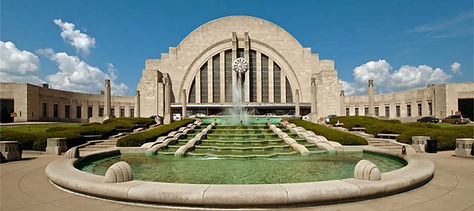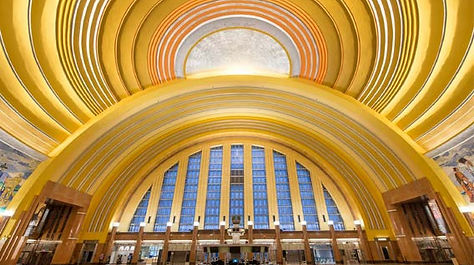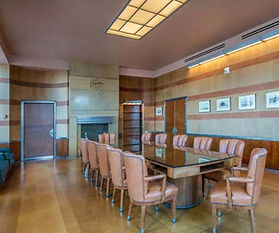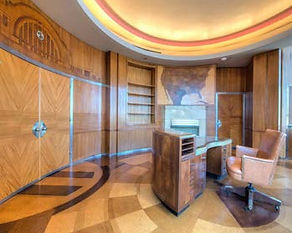All Aboard a Work of Art: Cincinnati Union Terminal
By J. Miles Wolf
Cincinnati Union Terminal, hailed as an Art Deco masterpiece, is a National Historic Landmark and has been named one of the top 50 architecturally significant buildings in the United States by the American Institute of Architects. When it was completed in 1933, its unique shape and flowing entryways were a modern statement of train station design. Having replaced five local train stations, the new unified station received great praise for its multilayered design and its ability to move thousands of passengers and hundreds of trains seamlessly. Local and national press called it a “Temple to Transportation.”
As the largest half-dome in the Western Hemisphere and one of the last great train stations built in America, the unique structure is the result of a last-minute architectural decision. The station was originally designed to be a grand neoclassical building with columns and arches. But after two years of construction, the owners asked the architects, Fellheimer & Wagner, to redesign the building in an up-to-date, less expensive style. Fellheimer & Wagner tasked its talented young architect Roland A. Wank, along with the French-born consultant and architect Paul Philippe Cret, to redesign the building in the modern style now known as Art Deco.
Cret and Wank were influenced by new European designs and modern styles emerging in the United States. They paid great attention to detail and created a building that was both functional and beautiful. Their use of art as a major component of the interior design created an exciting combination of custom-made artwork intertwined with modern architecture. They commissioned over 60 original installations, totaling over 18,000 square feet of artwork, for the new train station.
The Finnish architect Eliel Saarinen’s design for the 1919 Helsinki Central Station may have influenced the unique shape of the terminal’s exterior. Saarinen used Art Nouveau elements, including a large, arched entry full of glass windows. Cret and Wank took that design concept a step further when they designed the world’s largest arched, half-dome shaped building, which housed the Union Terminal’s more than 100-foot-high rotunda.
Union Terminal is instantly recognizable with its arching form, distinctive curvilinear shapes and gently stepped exterior. The location and orientation of its distinctive façade make the building even more spectacular. It sits high on a manmade hill visible from downtown Cincinnati, and the long, landscaped approach with a large, cascading water fountain makes it an impressive, welcoming sight.


LEFT: Detail of mosaic by Winold Reiss featuring a riverboat captain. RIGHT: 30-foot-tall façade bas-relief sculpture by Maxfield Keck.

Cincinnati Union Terminal façade with landscaped approach featuring a large, cascading water fountain.

Rotunda with 106-foot-high ceiling and 10-story arched wall of windows.

Detail of mosaic by Winold Reiss featuring a construction worker.

Boardroom featuring original table, cork and
wood walls, as well as a cork floor.
Cincinnati Union Terminal, hailed as an Art Deco masterpiece, is a National Historic Landmark and has been named one of the top 50 architecturally significant buildings in the United States by the American Institute of Architects. When it was completed in 1933, its unique shape and flowing entryways were a modern statement of train station design. Having replaced five local train stations, the new unified station received great praise for its multilayered design and its ability to move thousands of passengers and hundreds of trains seamlessly. Local and national press called it a “Temple to Transportation.”
As the largest half-dome in the Western Hemisphere and one of the last great train stations built in America, the unique structure is the result of a last-minute architectural decision. The station was originally designed to be a grand neoclassical building with columns and arches. But after two years of construction, the owners asked the architects, Fellheimer & Wagner, to redesign the building in an up-to-date, less expensive style. Fellheimer & Wagner tasked its talented young architect Roland A. Wank, along with the French-born consultant and architect Paul Philippe Cret, to redesign the building in the modern style now known as Art Deco.
Cret and Wank were influenced by new European designs and modern styles emerging in the United States. They paid great attention to detail and created a building that was both functional and beautiful. Their use of art as a major component of the interior design created an exciting combination of custom-made artwork intertwined with modern architecture. They commissioned over 60 original installations, totaling over 18,000 square feet of artwork, for the new train station.
The Finnish architect Eliel Saarinen’s design for the 1919 Helsinki Central Station may have influenced the unique shape of the terminal’s exterior. Saarinen used Art Nouveau elements, including a large, arched entry full of glass windows. Cret and Wank took that design concept a step further when they designed the world’s largest arched, half-dome shaped building, which housed the Union Terminal’s more than 100-foot-high rotunda.
Union Terminal is instantly recognizable with its arching form, distinctive curvilinear shapes and gently stepped exterior. The location and orientation of its distinctive façade make the building even more spectacular. It sits high on a manmade hill visible from downtown Cincinnati, and the long, landscaped approach with a large, cascading water fountain makes it an impressive, welcoming sight.

Lobby for Women’s restroom with cut linoleum mural by Pierre Bourdelle.

President’s office featuring original desk, inlaid wood walls, and cork floor by Pierre Bourdelle.
About the Author:
J. Miles Wolf is an artist, photographer, and publisher living in Cincinnati. He has published nine books and loves photographing architecture. He has been drawn to Art Deco architecture for many years.
All Photos: J. Miles Wolf © 2021
Article originally published in the Art Deco New York journal, Vol. 6, Issue 1, Winter 2021. View a digital version of the full journal here.
